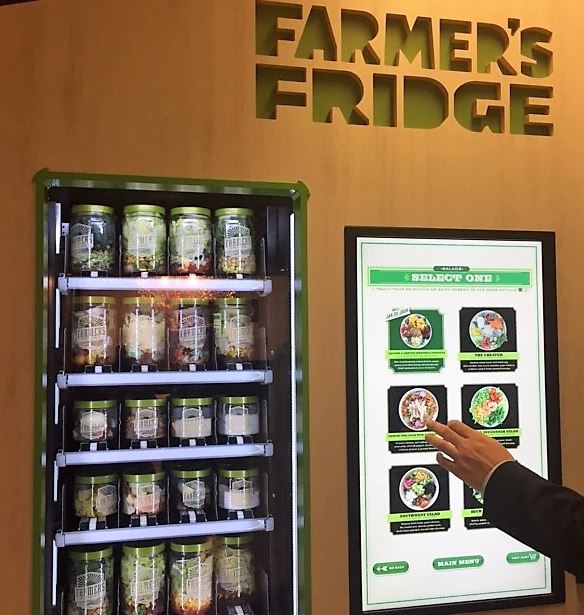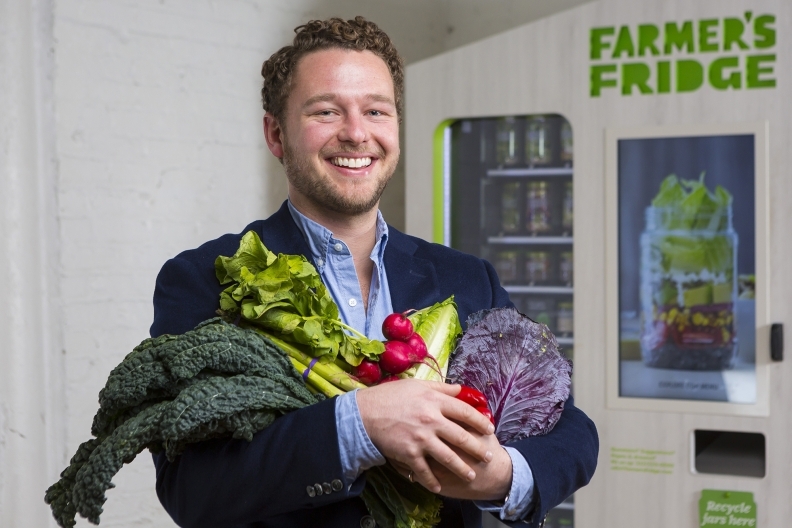For those always on the go, maintaining a healthy diet can be near impossible. These individuals recognize the benefits of a balanced diet but just don’t have the time to prepare packed lunches. This has led to the mushrooming of smart vending machines that don’t house high-sugar colas, candies and crisps, but are instead stocked with salads, sandwiches and juices. Deployed by Chicago-based Farmer’s Fridge, such IoT-powered food dispensers seek to revive the healthy eating habit, albeit with a modern twist. To this end, the startup secured $30M in a Series C round in September 2018.
Led by Innovation Endeavors, the venture capital firm co-founded by former Google CEO Eric Schmidt, the funding round also involved local investors such as DNS Capital, Dom Capital and Hyde Park Angels. Cleveland Avenue, which had contributed to Farmer’s Fridge’s $10M Series B round last year, also participated in this round. This surge in backing takes the total funds raised by the startup to $40M.
The Internet-connected ‘Fridges’, as their healthy vending machines are called, are technological marvels – devices that run firmware and feature a graphical user interface and cloud infrastructure.
With just a tap of its touchscreen menu and a swipe of your card, you can have instant access to kitchen-made, wholesome meals such Smoked Cheddar Cobb Salad, Tarragon Chicken Salad Wrap, and Almond Butter Oats Bowl. Priced between just $5 and $8, each of these items have mention of calorie count, potential allergens, and are even made from organic and local ingredients that are responsibly sourced.
Customers can even use the Farmer’s Fridge app to locate the Fridge closest to them, check its inventory, reserve food from that Fridge ahead of time, and attain customized deals based on user profile and past purchases. As users make more purchases via the app, the startup accumulates and analyzes more data that lets it further personalize further interaction.
Saving the planet one salad at a time
Usually, in the cold food vending machine business, wastage ends up being about 40% of the machine’s inventory. Farmer’s Fridge has fixed this issue with a supply chain hack – short timeline from production to delivery. Fresh food is prepared in their centrally-located kitchen (in West Town) and delivered within a matter of hours to Fridges, across the city, via temperature-regulated vehicles. The Fridges are restocked every morning, five to seven days a week. Also thanks to the company’s allocation algorithm, that tightly controls its inventory, Farmer’s Fridge ends up with only 5% leftovers.
To further reduce the wastage, the startup delivers leftover food to the Greater Chicago Food Depository, a local food bank. And food scraps that have crossed their expiry date are composted. In accordance with its commitment to the environment, Farmer’s Fridge claims to sell its products in BPA free and 100% recyclable jars. They also provide on-site recycling at the Fridges. Most impressive is the fact that the Fridges are super energy efficient, as compared to most fast food chains. They run on just about $25 of electricity per month.
From Gas Station Food to Healthy Eating
It was back in 2009 that Farmer’s Fridge Founder and CEO, Luke Saunders, first took cognizance of the need for accessible and healthy food service. Much like the current customers of Farmer’s Fridge, Saunders was also quite tired of eating junk food, while rushing for work.
The idea for health-friendly smart vending machines came to him as he was forced to fill his stomach with tasteless and unhealthy gas station food, while employed as a field salesperson with an industrial lubricant manufacturer. So, he began to muse about the possibility of marrying the efficiencies of fast-food restaurants with the convenience of the vending delivery system. The aim was to offer fresh, healthy food at an affordable price and in the most convenient manner.
At this point in time, he also noted that self-service IoT technology was really making waves, wherein smart vending machines could report real-time user activity and even integrate with data analytics programs. This would ensure that machine sales are tracked and wastage minimized. Sanders realized that the resulting business model could be quite profitable.
With this dream in mind, he went against the grain by turning down a raise and promotion at his last place of employment to launch a new-age vending machine company for organic food. In October 2013, Saunders put up the first Fridge.
“I never actually thought about it as vending,” Saunders said to Fast Casual. “It was more of a supply chain innovation to bring fresh meals to people at a restaurant-quality level. We think of ourselves as more of a restaurant from a food quality perspective.”
While several food businesses (such as restaurants) consider their service to be the USP, Farmer’s Fridge capitalizes on its technology and quality of food.
Each Fridge location has been described as “an unattended, 24/7 restaurant in 12 square feet,” serving “wholesome and delicious food.” By removing restaurant labor costs and optimising the supply chain, Farmer’s Fridge was able to sell their wares at a much cheaper rate than most made-to-order options.
Saunders admits that from selling a “couple hundred” meals per day, just three years ago, today Farmer’s Fridge sells 15,000 meals per day now.
The Bespoke Revenue Model
Since its launch in 2013, Farmer’s Fridge has deployed 200 smart vending machines, at 186 locations across Chicago and Milwaukee. These smart fridges can be found in hospitals, airports, pharmacies and even small office buildings. They are even present at an Amazon Go store in Chicago.
Farmer’s Fridge tweaks its revenue model basis the partner it is associating. From subsidized accounts to revenue shares, the partnership demands on the needs of each vertical. “In a hospital, they care more about having an amenity overnight for employees who don’t have access to a cafeteria than they do about profitability. At O’Hare International Airport, it’s a revenue share because of the traffic generated. For some retailers, it’s about the traffic Farmer’s Fridge brings to those places,” Saunders said to TechCrunch.
Competition, such as Byte Foods, Moniker (formerly Bodega) and Chowbotics also target similar high traffic locations.
Expanding the Fresh Food Reach
With the latest infusion of funds, Farmer’s Fridge hopes to continue growing from 130 employees to about 200 by end of 2019. According to the Chicago Tribune, within the same time period, it also hopes to more than double its fridge count from 185 to 400 or 500, within the Midwest region. They also plan to secure a larger production facility to keep up with the rising demand.
“One of the things we were able to prove over the last 18 months is how much value we can create by investing in our technology platform,” he said in a conversation with the Chicago Tribune. “We’re looking for senior leadership in engineering, product and IT.”
Beyond Chicago and Milwaukee, Farmer’s Fridge has its sights on supplying fresh food to cities such as Detroit, Indianapolis, Cincinnati and St. Louis. Once that target is achieved, its logical next step would be to establish a presence in a second region, outside the Midwest.
Since the company trades in preservative-free food, an expected hitch in starting operations in a new region (away from its area of production) would be keeping the produce fresh. They will need to set up kitchens and hire cooks and delivery drivers close to wherever they open up a new machine location.
Locally-grown produce by startups such as Gotham Greens could be part of the answer. Partnership with such agricultural startups could potentially be a way for Farmer’s Fridge to live up to its promise of “transforming the supply chain through technology and creating a new paradigm for fresh food.”
Subscribe to our newsletter





